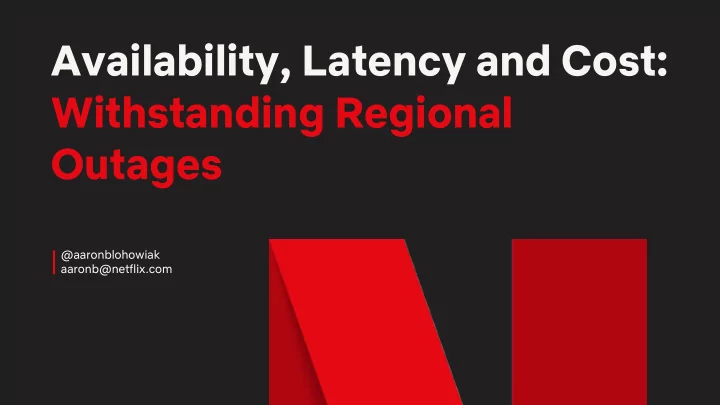

Availability, Latency and Cost: Withstanding Regional Outages @aaronblohowiak aaronb@netflix.com
What to expect ● Why? ● Overview! ● Algebraic Models ○ Availability! ○ Latency! ○ Cost! ● Architecture! @aaronblohowiak
Why?
You never let a serious crisis go to waste. And what I mean by that it's an opportunity to do things you think you could not do before. - Rahm Emanuel
Good, not great. @aaronblohowiak
Good, not great. 1. Instability @aaronblohowiak
Good, not great. 1. Instability 2. Infrequency @aaronblohowiak
Good, not great. 1. Instability 2. Infrequency 3. GOTO 1. @aaronblohowiak
Source: https://martinfowler.com/bliki/FrequencyReducesDifficulty.html
One of my favorite soundbites is: if it hurts, do it more often. - Martin Fowler
Operational Burden 1. Alerts @aaronblohowiak
Operational Burden 1. Alerts 2. Canaries @aaronblohowiak
Operational Burden 1. Alerts 2. Canaries 3. WoW Metrics @aaronblohowiak
From Burden to Advantage @aaronblohowiak
In general, freedom and rapid recovery is better than trying to prevent error. We are in a creative business, not a safety-critical business. - jobs.netflix.com/culture
Overview
Problem Description Number of Regions @aaronblohowiak
@aaronblohowiak
@aaronblohowiak
100% Capacity @aaronblohowiak
Problem Description Number of Regions @aaronblohowiak
N+1 Architecture @aaronblohowiak
100% 1+0 (no spare) @aaronblohowiak
100% 100% 1+1 @aaronblohowiak
100% 100% 1+1 = 200% @aaronblohowiak
2+1 50% 50% 50% @aaronblohowiak
2+1 = 150% 50% 50% 50% @aaronblohowiak
2+1 = 150% ?!?!?!?!?! 50% 50% 50% @aaronblohowiak
2+1 Overview @aaronblohowiak
@aaronblohowiak
@aaronblohowiak
@aaronblohowiak
Excess Risk @aaronblohowiak
@aaronblohowiak
@aaronblohowiak
@aaronblohowiak
Algebraic Models
All models are wrong but some are useful - George Box
Availability
Distribution of Change Number of Regions Balance of Traffic @aaronblohowiak
Distribution of Change Number of Regions Balance of Traffic @aaronblohowiak
Distribution of Change Number of Regions Balance of Traffic @aaronblohowiak
@aaronblohowiak
Distribution of Change Number of Regions Balance of Traffic @aaronblohowiak
Distribution of Change Number of Regions Balance of Traffic @aaronblohowiak
@aaronblohowiak
Distribution of Change Number of Regions Balance of Traffic Empirical Risk @aaronblohowiak
Latency
Which Latency?
Normal vs Failover
Latency ??? Availability Cost @aaronblohowiak
If you’re successful, hourly demand maps to population by longitude. - Blohowiak’s Third Law
Measuring Latency @aaronblohowiak
@aaronblohowiak
@aaronblohowiak
@aaronblohowiak
Measuring Latency @aaronblohowiak
Measuring Latency @aaronblohowiak
Cost
2+1 50% 50% 50% @aaronblohowiak
@aaronblohowiak
In N+1 Architecture, minimal failover overhead is 1/N. @aaronblohowiak
In N+1 Architecture, minimal failover overhead is 1/N. Cost = 100% + 1/N @aaronblohowiak
In N+1 Architecture, minimal failover overhead is 1/N. Cost = 100% + 1/N If costs are pure throughput @aaronblohowiak
100%
Throughput Portion 100% Database Portion
2+1 @aaronblohowiak
2+1 All data everywhere
2+1 All data everywhere >150%
Data Base Portion Region Replication Factor @aaronblohowiak
In RRF=All T is Throughput Cost T = (1 - DBP) * (1 + 1/N) D is DB Cost D = DBP * (N + 1) Total = T + D @aaronblohowiak
@aaronblohowiak
In RRF=2 T is Throughput Cost T = (1 - DBP) * (1 + 1/N) D is DB Cost D = DBP * 2 Total = T + D @aaronblohowiak
@aaronblohowiak
@aaronblohowiak
Cost Summary ● 50% throughput overhead plus tripled database cost for 3-region RRF=all. ● 25% throughput overhead plus doubled database cost for 5-region RRF=2, plus a lot of complexity. @aaronblohowiak
Architecture
Multi-Site Fault Isolation ● No cross-region Requests! ● Stateless or Async* Replication! ○ Cache Replication! ● Change One Region at a Time! @aaronblohowiak
To shard or not to shard? That is the question. @aaronblohowiak
To shard or not to shard? That is the question. Steering ● @aaronblohowiak
To shard or not to shard? That is the question. Steering ● Rebalancing & Rehoming ● @aaronblohowiak
To shard or not to shard? That is the question. Steering ● Rebalancing & Rehoming ● Cost ● @aaronblohowiak
To shard or not to shard? That is the question. Steering ● Rebalancing & Rehoming ● Cost ● Satellites ● @aaronblohowiak
To shard or not to shard? That is the question. Steering ● Rebalancing & Rehoming ● Cost ● Satellites ● Graph vs Multi-tenant ● @aaronblohowiak
How to RRF=2 with 1/N overhead? Central Savior ● Ring ● Custom Hashing ● @aaronblohowiak
Central Savior @aaronblohowiak
Central Savior @aaronblohowiak
Ring Regions @aaronblohowiak
Ring Regions @aaronblohowiak
Ring Regions @aaronblohowiak
One More Thing @aaronblohowiak
What percentage of your outages come from regional failures? @aaronblohowiak
Many of the availability benefits come from isolation, not regions. @aaronblohowiak
What percentage of your outages come from database failures? @aaronblohowiak
Maybe for you and your org having logical stacks makes the most sense. @aaronblohowiak
Closing Thoughts @aaronblohowiak
Questions? @aaronblohowiak
Recommend
More recommend